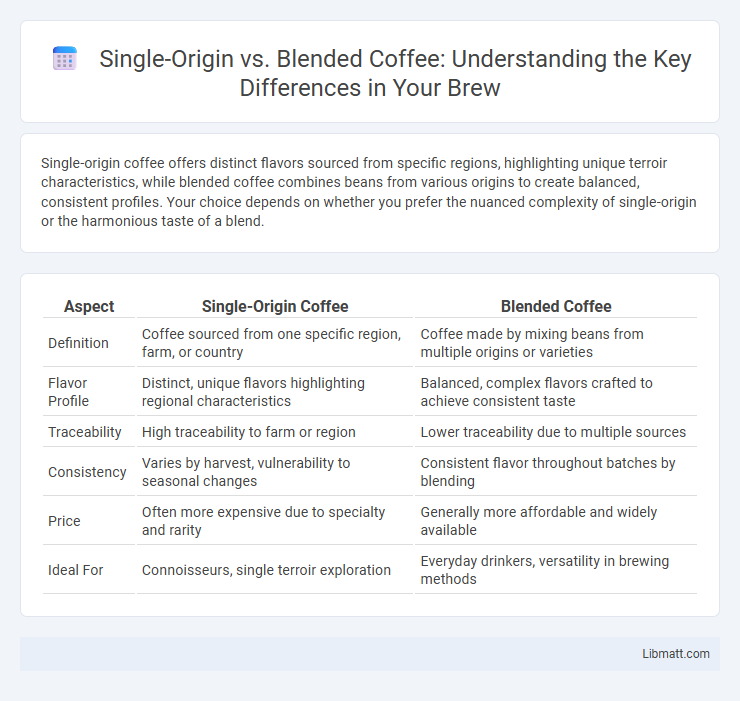Single-origin coffee offers distinct flavors sourced from specific regions, highlighting unique terroir characteristics, while blended coffee combines beans from various origins to create balanced, consistent profiles. Your choice depends on whether you prefer the nuanced complexity of single-origin or the harmonious taste of a blend.
Table of Comparison
| Aspect | Single-Origin Coffee | Blended Coffee |
|---|---|---|
| Definition | Coffee sourced from one specific region, farm, or country | Coffee made by mixing beans from multiple origins or varieties |
| Flavor Profile | Distinct, unique flavors highlighting regional characteristics | Balanced, complex flavors crafted to achieve consistent taste |
| Traceability | High traceability to farm or region | Lower traceability due to multiple sources |
| Consistency | Varies by harvest, vulnerability to seasonal changes | Consistent flavor throughout batches by blending |
| Price | Often more expensive due to specialty and rarity | Generally more affordable and widely available |
| Ideal For | Connoisseurs, single terroir exploration | Everyday drinkers, versatility in brewing methods |
What Is Single-Origin Coffee?
Single-origin coffee refers to beans sourced from a specific geographic region, farm, or estate, highlighting unique flavors tied to its precise location and growing conditions. This type of coffee offers distinct taste profiles that reflect the soil, climate, and altitude, allowing You to experience authentic and traceable coffee characteristics. Single-origin choices emphasize transparency and quality, often preferred by coffee enthusiasts seeking to explore diverse and pure flavor notes.
Defining Blended Coffee
Blended coffee combines beans from multiple origins, offering a balanced and consistent flavor profile that highlights complementary characteristics. Roasters create blends to achieve a specific taste, aroma, and body that single-origin beans alone may not provide. This approach ensures uniform quality and versatility for various brewing methods.
Key Differences Between Single-Origin and Blended Coffee
Single-origin coffee comes from one specific region or farm, offering distinct flavors influenced by its unique terroir, while blended coffee combines beans from multiple origins to create a balanced and consistent taste profile. Single-origin coffees highlight the unique characteristics of their location, such as fruity, floral, or earthy notes, whereas blends aim to harmonize varying flavor profiles to achieve complexity and smoothness. Understanding these key differences helps you select coffee that matches your preference for either distinctive regional flavors or a well-rounded, reliable cup.
Flavor Profiles: Unique vs Balanced
Single-origin coffee offers distinct flavor profiles that reflect the specific region's soil, climate, and processing methods, often resulting in bright, fruity, or floral notes with complex acidity. Blended coffee combines beans from multiple origins to create a consistent, balanced flavor, emphasizing harmony between sweetness, body, and acidity for broad appeal. Coffee connoisseurs seeking unique, terroir-driven taste experiences prefer single-origin, while those valuing smooth and reliable flavor often choose blends.
Sourcing and Traceability
Single-origin coffee is sourced from a specific region, farm, or producer, offering clear traceability and allowing consumers to experience distinct flavor profiles linked to its geographic origin. Blended coffee combines beans from multiple origins, often to achieve a balanced or consistent taste, but its traceability is less precise due to the mixing of various sources. Transparent sourcing in single-origin coffee supports ethical practices and quality control, while blends prioritize flavor harmony over detailed provenance.
Impact on Quality and Consistency
Single-origin coffee offers distinctive, traceable flavor profiles that reflect specific geographic regions, enhancing quality through unique terroir characteristics. Blended coffee ensures consistency by combining beans from multiple origins, balancing fluctuations in harvest quality and maintaining a uniform taste across batches. This balance between unique quality and reliable consistency determines the choice between single-origin and blended coffee in specialty and commercial markets.
Brewing Methods for Single-Origin vs Blend
Single-origin coffee typically benefits from manual brewing methods such as pour-over or Chemex, which highlight its unique flavor nuances and terroir characteristics. Blended coffee is often more versatile and balanced, making it well-suited for espresso machines and automatic drip brewers that emphasize consistency and body. Selecting the appropriate brewing method enhances the inherent qualities of each coffee type, ensuring a satisfying cup for different taste preferences.
Price Comparison: Value and Cost
Single-origin coffee often commands a higher price due to its unique flavor profiles and limited availability, appealing to specialty coffee enthusiasts seeking distinct taste experiences. Blended coffee typically offers better value for daily consumption, combining beans from multiple sources to balance flavor, consistency, and cost-effectiveness. Consumers prioritize single-origin for premium quality and traceability, while blended coffee remains a cost-efficient choice without compromising overall flavor.
Sustainability and Ethical Considerations
Single-origin coffee often supports sustainable farming practices by promoting biodiversity and fair trade certifications, ensuring farmers receive equitable income and reducing environmental impact. Blended coffee can incorporate beans from multiple regions, offering a balance of flavors while sometimes obscuring individual farmers' contributions and complicating traceability. You should prioritize single-origin options if ethical sourcing and supporting small-scale producers through transparent supply chains are important to your coffee choice.
Choosing the Right Coffee for Your Palate
Single-origin coffee offers unique flavors tied to specific regions, highlighting distinct tasting notes from soil, climate, and altitude, ideal for those exploring diverse, nuanced profiles. Blended coffee combines beans from various origins, creating balanced flavors that cater to a consistent and harmonious taste experience. Understanding your palate preferences helps you choose single-origin for complexity or blends for smoothness, ensuring your coffee enjoyment aligns with your flavor expectations.
Single-origin vs blended coffee Infographic

 libmatt.com
libmatt.com